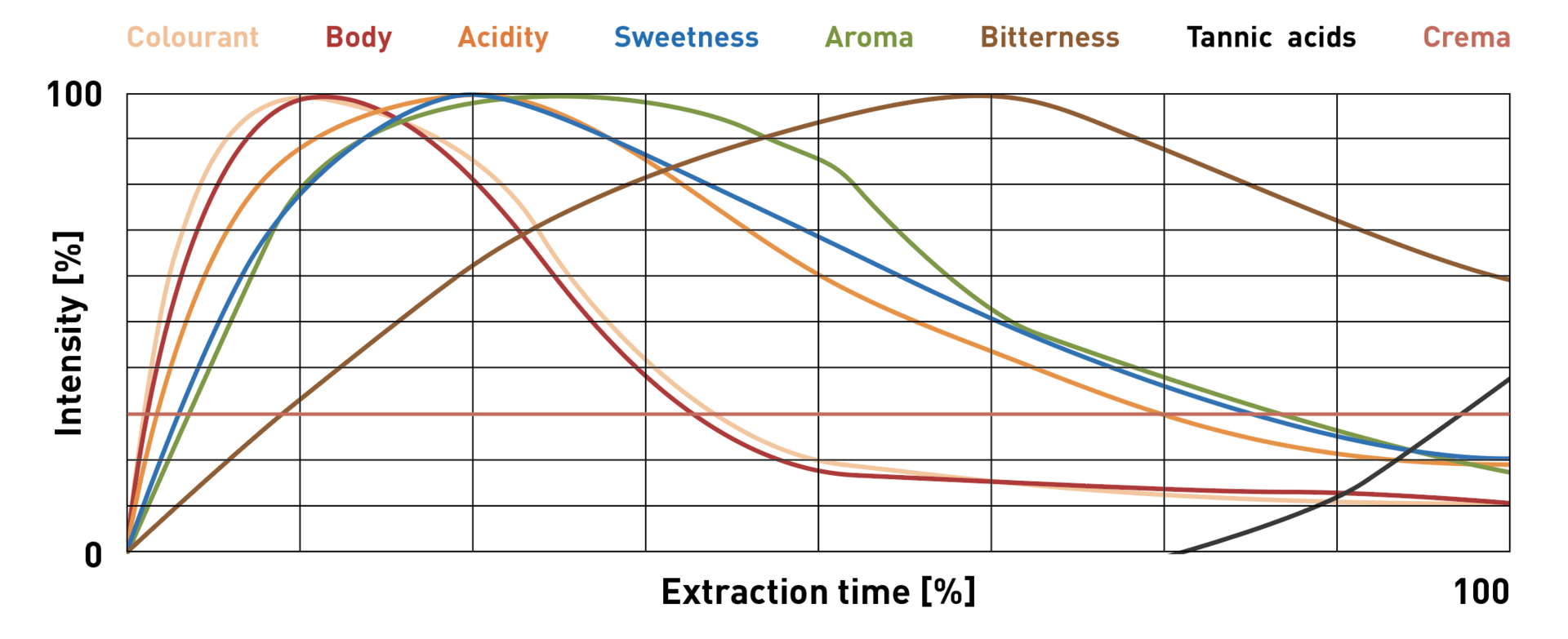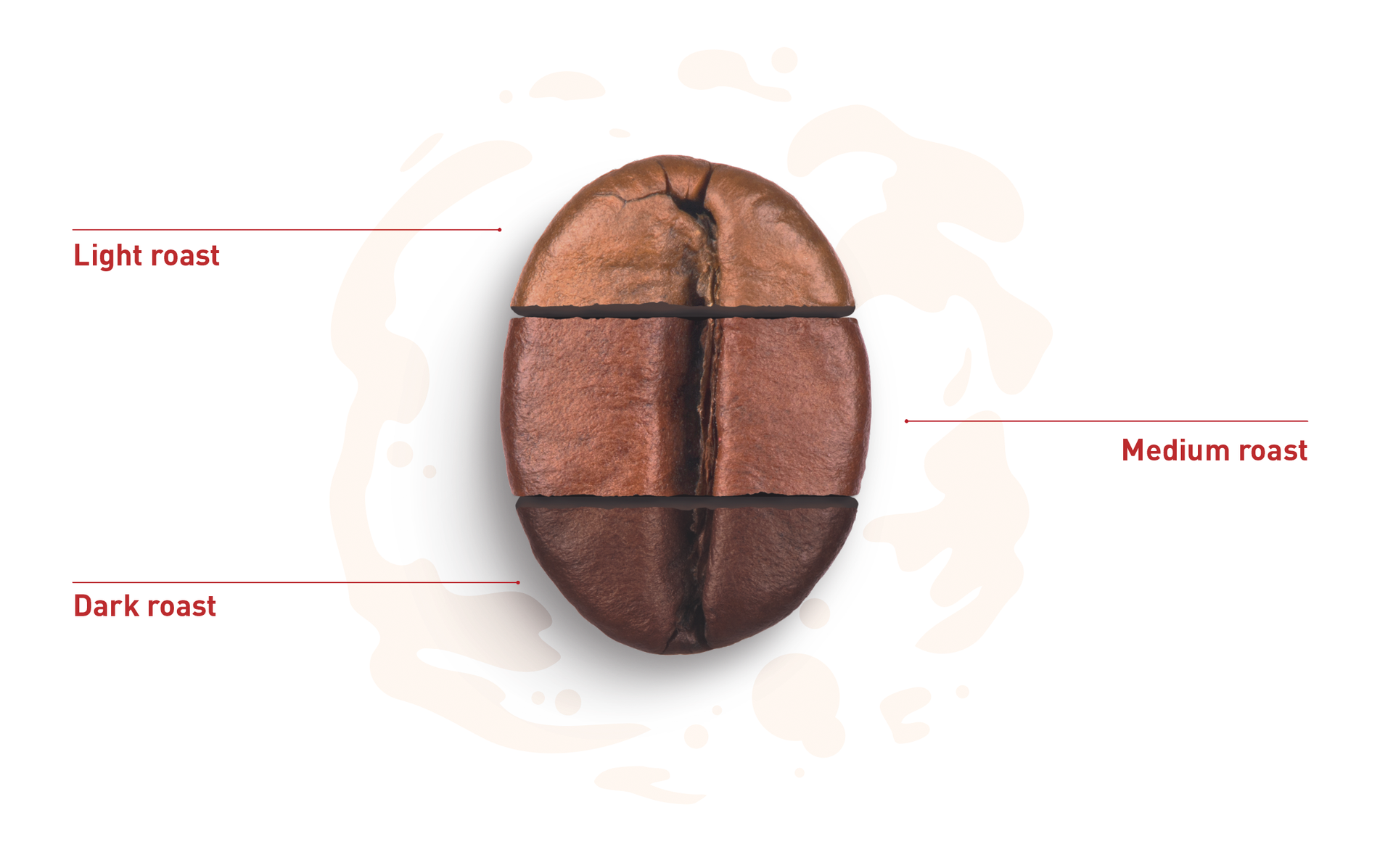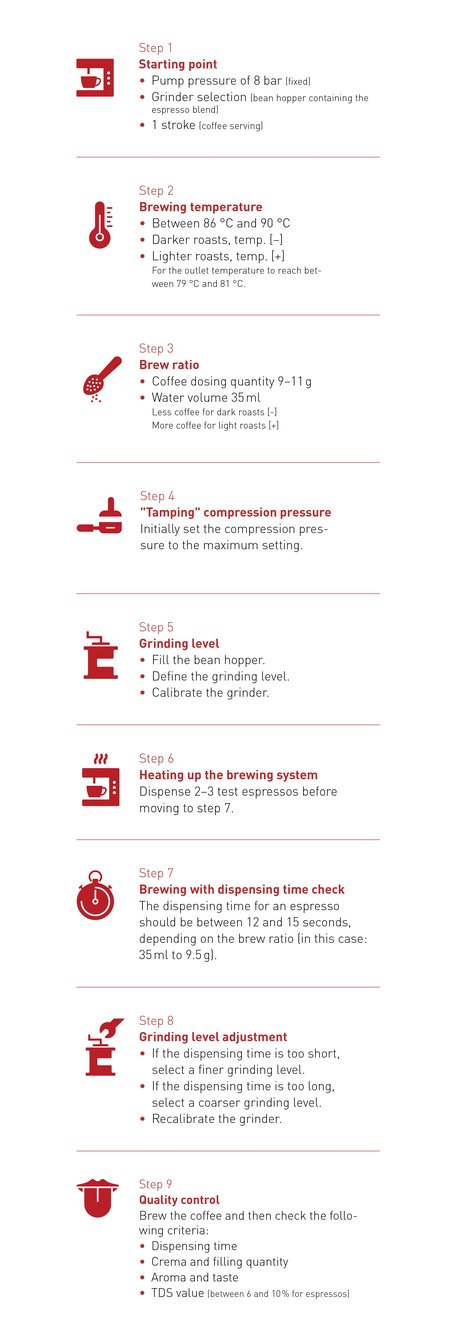That’s how its done!
Everything you need to know to prepare the perfect espresso
Today we celebrate the espresso day. We want to take the opportunity and tell you everything you need to know to prepare the perfect espresso.
To begin some theory about taste profile and perception of an aroma
A taste profile is the combination of taste sensations on the tongue (taste buds), the perception of an aroma (orthonasally and retronasally) as well as the mouthfeel (texture, body, balance = tactile perception).
The perfect flavour profile consists of a balanced proportion of aromas/fragrances, flavour components – particularly sought-after acidity and bitterness components – and a pleasant mouthfeel, which together provide a balanced, enjoyable experience.
Achieving a balanced taste profile in the cup requires a carefully adapted and executed brewing process in addition to a good water and coffee quality.
The brewing process in a coffee machine is primarily influenced by the following criteria: brew ratio, brewing temperature, compression pressure, pump pressure and grinding level.
Visually, the perfect espresso has a golden or hazelnut brown, fine-pored crema with a dense consistency.
Step 1: Flavour definition
Taste
The tongue is able to perceive five tastes: sweet, acidic, bitter, salty and umami.
Identifying which taste components are perceived most distinctly on the tongue is a helpful step in describing the taste accurately. A tingling sensation around the tip, along the sides and even under the tongue, indicates that the acidity is well perceived. If you do not feel anything until you swallow the coffee, and then feel a light scratching sensation or a slightly dry feeling, you may be perceiving the bitterness.





The points shaded in colour in the graphic are not the only locations where sweet, acidic, savoury, bitter and umami are perceived. However, when identifying the various tastes, they help to identify the points at which the respective taste is perceived as the strongest.
The very subtle, light acids define the structure and character of the beverage in particular.
The taste definition alone does not present a balanced picture of the coffee beverage. As well as the taste, the ideal flavour profile also includes the smell/aroma and mouthfeel.
Smell/aroma
The nose perceives the different smells/aromas that give each coffee type its individuality (orthonasally and retronasally). Coffee aromas offer a myriad of different smells: from floral and fruity to berry-like and herb-like, depending on the origin of the coffee (enzymatic aromas) as well as different roasting aromas with chocolatey, nutty, spicy and even ashy/ smoky notes, depending on the roasting type, roasting level and/or coffee variety.
Mouthfeel
Another important point is the oral sensation, also known as the sensory impression. The body and balance are mainly described here. The body describes the perception of the fullness and viscosity of a beverage: creamy, syrupy, velvety or light and watery. The balance indicates whether the coffee is well-balanced and the characteristics of taste, aroma and mouthfeel are harmonised with one another.
Step 2: Extraction
Extraction occurs when hot water is forced through the compressed ground coffee under pressure. This causes the oily and fatty substances unique to the coffee to separate from the powder and form a dense, fine-pored, creamy layer known as the crema. As mentioned at the beginning, in addition to the brewing and compression pressure, the grinding level, relevant brewing time, brew ratio and brewing temperature also influence the results in the cup and therefore the quality of the beverage.
We make a distinction between the preparation time (including grinding), the dispensing time (moment the pump starts until the beverage is dispensed) and the extraction time (contact time between water and ground coffee).
During extraction, the various substances in the coffee (colourant, body, acidity, etc.) are released at different times. The extraction time therefore determines the amount of coffee components in the beverage, among other things.
The following figure shows the tendency of different components/substances being released during extraction in a fully automatic coffee machine (dispensing time of 12 to 15 seconds for a single espresso or plus/minus 25 seconds for a double beverage).

Step 3: Selecting the coffee
The key to maximising your coffee enjoyment is selecting a good quality coffee.
With an espresso blend (espresso: short contact time with water and dark roast), the roasted aromas are particularly accentuated. In other words, a strong aroma with a long and pleasant aftertaste and a creamy, balanced mouthfeel. You recognize dark roast easily by paying attention to the following:
- Tendency to be more bitter.
Aromas: somewhat smoky or like tobacco, depending on the variety, origin and preparation method. - Works very well for espressos. The bitterness and body harmonise very well when the coffee is prepared with a small quantity of water.
- A very dark roast makes the espresso taste smoky and even caramel aroma notes develop when combined with milk.

Coffee freshness
As soon as coffee comes into contact with oxygen and heat, it starts to lose its aroma. The coffee beans should therefore always be stored airtight in their original packaging in a cool, dark place for as long as possible.
The bean hoppers on the coffee machine should only be filled with the amount required for the day to prevent the aroma from escaping from the beans. If the packaging is left open, the coffee can lose many of its aromas within hours.
The roasting date or the roasting age of the coffee also influences the quality in the cup. Coffee must be allowed to rest for a certain time after roasting to allow so-called "degassing". Freshly roasted coffee beans release large quantities of carbon dioxide (CO2), even after several days. The use of an aroma valve in the packaging means that freshly roasted beans can be filled and packaged directly with no or very little loss of aroma. The valve allows excess gas to escape without any oxygen entering the packaging. Once the coffee has degassed, there is hardly any carbon dioxide left in the beans. The coffee is then "ready to drink". The nuances of flavour have developed sufficiently and are much more pronounced than immediately after roasting. With dark roasts, this process takes around two to three weeks, whereas with lighter roasts the process is slightly quicker.
Step 4: Water quality
Depending on the brewing method, coffee can consist of up to 99 percent water. An essential ingredient contributing to your enjoyment of coffee.
The water quality influences the coffee extraction process as well as the flavour of the coffee due to the following factors:
- The hardness of the water (total hardness and alkalinity), expressed in French hardness degrees [°fH] or German hardness degrees [°dH].
- The pH value of the water (acidic or basic/alkaline), measured on a scale from 0 to 14.
Ideal water for coffee should have a balanced content of minerals such as calcium and magnesium, as well as an adequate total hardness and alkalinity. This is the only way that coffee can develop its full aroma.
Perfect water for coffee should have the following characteristics:
- Odourless, clear and hygienic
- Does not contain any coarse or fine particles
- A total hardness higher than the alkalinity
- Total hardness 3-6 °dH (50-108 ppm CaCO3)
- Alkalinity 2–4 °dH (40–75 ppm CaCO3)
- A pH value between 6.5 and 8.0
- An electrical conductivity (in [μS/cm] at 20 °C) of less than 50 times the alkalinity in [°dH]
More about water, the influence of water parameters and possible effect on the coffee beverage can be found here.
Step 5: Guide to setting the perfect espresso

Depending on the coffee variety, the dispensing time of an espresso with 9.5 g of ground coffee and 35 ml of water should be 12 to 15 seconds, provided that two grinders are available. The dispensing time of a lungo/café crème with 9.5 g ground coffee and 110 ml water should be 18 to 22 seconds.
